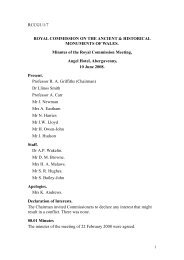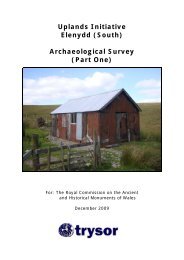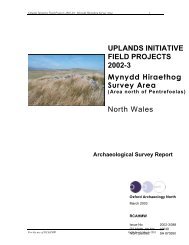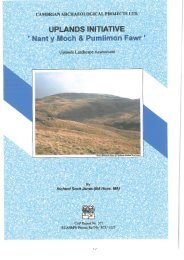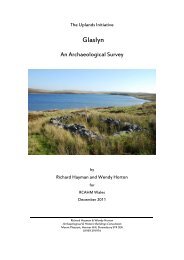Banc y Celyn, Brecknockshire - Royal Commission on the Ancient ...
Banc y Celyn, Brecknockshire - Royal Commission on the Ancient ...
Banc y Celyn, Brecknockshire - Royal Commission on the Ancient ...
- No tags were found...
Create successful ePaper yourself
Turn your PDF publications into a flip-book with our unique Google optimized e-Paper software.
Uplands Initiative – <str<strong>on</strong>g>Banc</str<strong>on</strong>g> y <str<strong>on</strong>g>Celyn</str<strong>on</strong>g> 20083.3.9 The significance of Medieval and Post Medieval settlement and agricultureThe widespread evidence for settlement or agricultural activity within <strong>the</strong> study clearlyshows that <strong>the</strong> identifiable human impact <strong>on</strong> <strong>the</strong> local landscape has been greatestduring <strong>the</strong> historic period.It is likely that many of <strong>the</strong> earthwork platforms and huts found in <strong>the</strong> area wereassociated with medieval or early post medieval pastoral activity. Where settlementsappear to be associated with enclosure and cultivati<strong>on</strong>, <strong>the</strong>y may represent early postmedievalencroachment <strong>on</strong>to <strong>the</strong> mountain wastes, as a populati<strong>on</strong> increase in <strong>the</strong>countryside created more pressure <strong>on</strong> <strong>the</strong> land resource. However, as <strong>the</strong> features inquesti<strong>on</strong> are invariably absent from early 19 th century maps of <strong>the</strong> area, <strong>the</strong>ir chr<strong>on</strong>ologyand functi<strong>on</strong> are impossible to assess <strong>on</strong> <strong>the</strong> basis of field observati<strong>on</strong> al<strong>on</strong>e.There are a number of characteristics relevant to <strong>the</strong> settlements of <strong>the</strong> study area thatseem to be of significance. The most obvious is <strong>the</strong> clustering of nearly all <strong>the</strong> desertedsettlement sites in <strong>the</strong> nor<strong>the</strong>rn porti<strong>on</strong> of <strong>the</strong> study area. Several explanati<strong>on</strong>s may beoffered as to why this should be so. It may be that <strong>the</strong> lower hills to <strong>the</strong> south were moreeasily accessible to <strong>the</strong> lowland communities of <strong>the</strong> Wye valley and <strong>the</strong>refore permanen<strong>the</strong>rding stati<strong>on</strong>s or shepherding cottages were not needed. Alternatively, it may be that<strong>the</strong> equivalent sites in <strong>the</strong> sou<strong>the</strong>rn half of <strong>the</strong> study area have been subsumed into <strong>the</strong>area of enclosed land and became permanent farmsteads, such as Cwm Hafotty, BlaenLlwyn Ddu or Gwaun Ymrys<strong>on</strong> (<strong>the</strong> latter two lie outside <strong>the</strong> study area), all of whichmay have originally stood <strong>on</strong> <strong>the</strong> open comm<strong>on</strong>. Evidence of <strong>the</strong>ir original settlementsmay have been lost after centuries of land improvement and farming. This is certainlypossible, as a similar phenomen<strong>on</strong> seemed to have occurred <strong>on</strong> <strong>the</strong> adjacent SENTADry Training Area lands to <strong>the</strong> east (Hall & Sambrook, 2008b).The settlement sites recorded in <strong>the</strong> NMR and regi<strong>on</strong>al HER are mainly earthworkplatforms and l<strong>on</strong>g huts. There is very little c<strong>on</strong>venient building st<strong>on</strong>e in <strong>the</strong> area,<strong>the</strong>refore timber, clom and reed thatch are likely to have been <strong>the</strong> main buildingmaterials until later post medieval times, all material which would have been locallyavailable. The exploitati<strong>on</strong> of locally available resources in this manner was reflectedacross most upland regi<strong>on</strong>s in <strong>the</strong> past.Although <strong>the</strong> forms of <strong>the</strong> single l<strong>on</strong>ghouse and small number of l<strong>on</strong>g huts found in <strong>the</strong>area compare with similar structures of medieval and post medieval date in o<strong>the</strong>r areas,<strong>the</strong> platforms recorded at <str<strong>on</strong>g>Banc</str<strong>on</strong>g> y <str<strong>on</strong>g>Celyn</str<strong>on</strong>g> show some diversity of form and locati<strong>on</strong>.Three platforms which had been recorded before <strong>the</strong> 2009 survey display <strong>the</strong> variati<strong>on</strong>sthat can be found am<strong>on</strong>gst this outwardly simple m<strong>on</strong>ument type. Cwmhindda PlatformIII (NPRN 247061) is a classic, bare, cross-c<strong>on</strong>tour platform, measuring up to 20ml<strong>on</strong>g, by 7m wide. There seems to be little similarity between such an earthwork and<strong>the</strong> Pant y Llyn Hill Platform II (NPRN 247046), which is cut almost parallel to <strong>the</strong>c<strong>on</strong>tour and measures <strong>on</strong>ly 9m x 6m. Both of <strong>the</strong>se platforms are associated with o<strong>the</strong>rsettlement features, but <strong>the</strong>re is no evidence of cultivati<strong>on</strong> in <strong>the</strong>ir vicinity and it mustbe presumed that <strong>the</strong>y bel<strong>on</strong>g to purely pastoral settlement sites, possibly medievalhafod complexes. They are close toge<strong>the</strong>r, being separated <strong>on</strong>ly by a hill and some200m, yet we cannot know if <strong>the</strong>y were c<strong>on</strong>temporary sites or in any way related. TheCwmhindda platform sits al<strong>on</strong>gside a group of l<strong>on</strong>g huts and smaller platforms; Pant y63


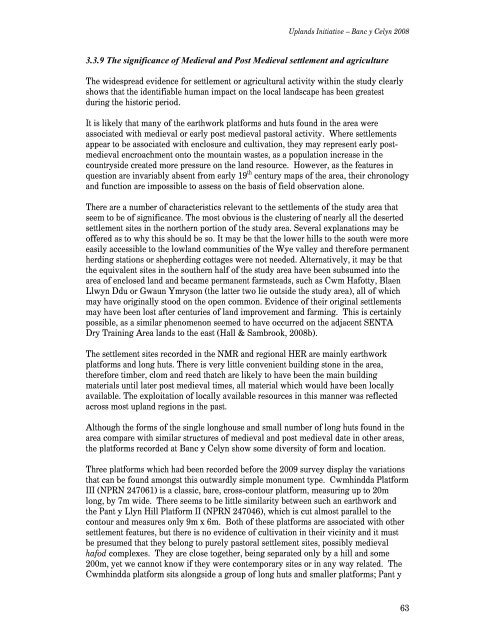

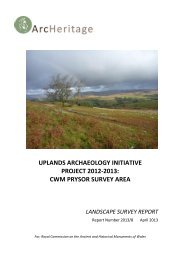
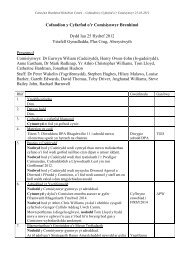
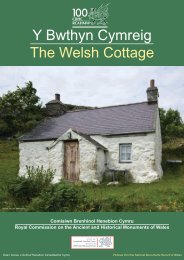
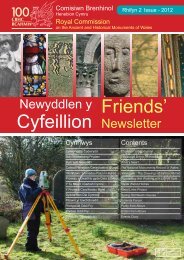
![The Source of the Usk Walk [2012 PDF]](https://img.yumpu.com/49285699/1/190x245/the-source-of-the-usk-walk-2012-pdf.jpg?quality=85)


